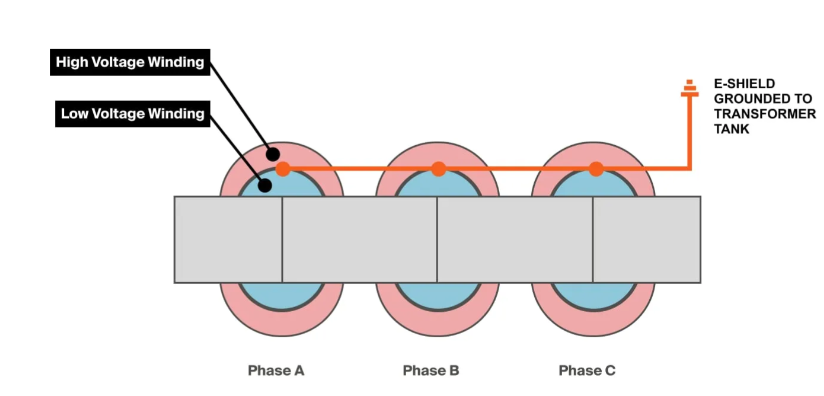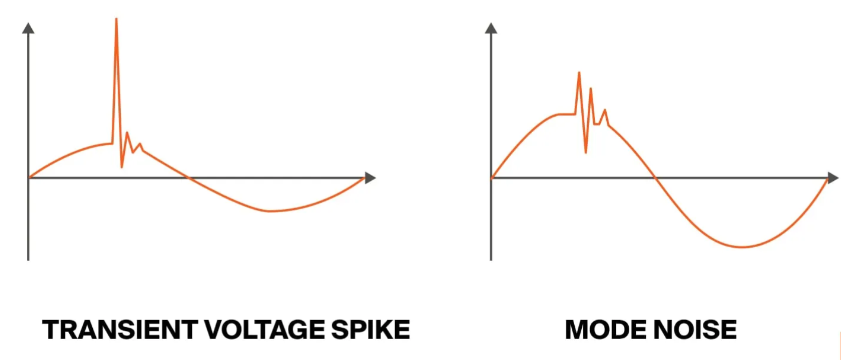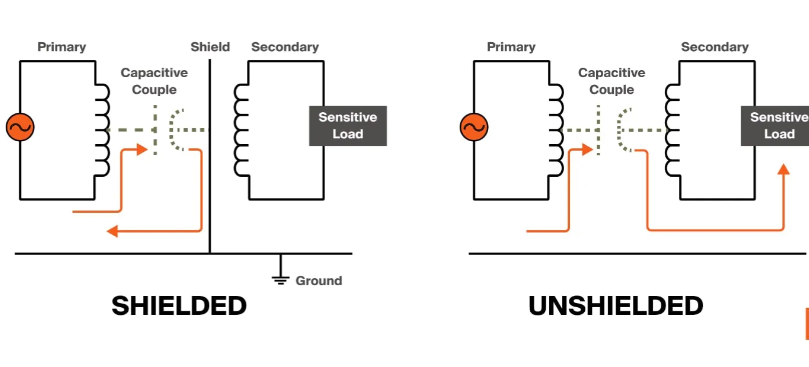What is an E-shield?
An electrostatic shield is a thin non-magnetic conductive sheet. The shield can be copper or aluminum. This thin sheet goes between the transformer’s primary and secondary windings. The sheet in each coil connects together with a single conductor that bonds to the transformer chassis.

What do E-shields do in transformers?
E–shields redirect harmful voltage disturbances away from a transformer’s coils and sensitive electronics in electrical systems. This protects the transformer and the system connected to it.
Let's look at this in more detail starting with what E-shields protect against.
Attenuation
Many modern electrical circuits are subject to transient spikes and mode noise. A grounded E-shield attenuates (minimizes) these disruptions.

The above image on the left shows a typical transient voltage spike. This type of sharp increase in supply voltage results from common office equipment like computers or photocopiers. Inverters also are a common source of transient spikes. The image on the right shows an example of mode noise in an electrical circuit. Mode noise is common in electronic circuits. Poorly wired systems with improper cable shielding often suffer from mode noise.
Now let's look at how an E-shield deals with these disruptions.
Capacitive Coupling
A grounded E-shield reduces capacitive coupling between the primary and secondary windings. Rather than coupling with the secondary winding, the primary winding couples with the E-shield. The grounded E-shield provides a low impedance path to ground. Voltage disturbances are redirected away from the secondary winding. This also works from the other end of the transformer (secondary to primary).

Transient spikes and mode noise can damage transformers and other electrical equipment. An electrostatic shield between the high voltage and low voltage coils reduces such risks. A crucial consideration when supplying power to sensitive electronics.
Examples of Transformers that Use an E-shield
Solar & Wind Transformers
Harmonic disruptions and special switching from solar inverters get transferred to the utility grid. These voltage disturbances create impulse-like effects in the HV winding feeding the grid. Transient overvoltage spikes on the utility side can also pass to the inverter. These overvoltage events can damage an inverter’s sensitive components. E-shields provide protection for both the transformer, the grid, and the inverter.
Learn more about solar transformer sizing and design requirements.
Drive Isolation Transformers
Drive isolation transformers are built to withstand high frequency voltage disturbances (harmonics). Such disturbances result from equipment like motor drives (or VFDs). Hence the word “drive” in the name. In addition to harmonics, motor drives may also introduce other voltage disturbances (like mode noise). This is where the E-shield comes into play. Drive isolation transformers include at least one E-shield between the HV and LV coils. Multiple shields may be used as well. E-shields may be placed between the inner coils and core limbs also.
Applications with voltage disturbances (like transient spikes and mode noise) benefit from a transformer with an E-shield. E-shields are inexpensive, and offer a significant return on investment where power quality issues are a threat.
Post time: Aug-08-2024

